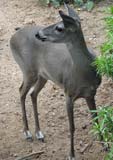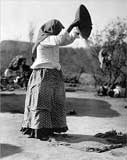People of the Legends
Indigenous People of North America - Papago (Tohono O'odham)
Recent History
The early Pima lived in permanent villages and used irrigation to grow food like the Hohokam. The early Papago were semi-nomadic, which means they lived in different places during each year.
 In the warm months they lived on the desert floor near arroyos or deep gullies, where water flowed after rain in the mountains.
In the warm months they lived on the desert floor near arroyos or deep gullies, where water flowed after rain in the mountains.
They planted trees like cottonwoods and willows in the path of the floods to move the water around their crops.
They called these places “field villages.” Scientists call the way they farmed floodplain irrigation.
 In the cold months they lived in the mountains and used water from springs. These were “well villages.” They hunted deer and other animals for food. If crops failed or they ran out of food, they joined a Pima village for a while and worked to earn their keep.
In the cold months they lived in the mountains and used water from springs. These were “well villages.” They hunted deer and other animals for food. If crops failed or they ran out of food, they joined a Pima village for a while and worked to earn their keep.
Each year the Papago walked across the hot desert to salt flats near the Gulf of California. They believed the rain spirits lived there and they prayed for water for their crops. They also collected salt, which they traded with other tribes.
 The Papago and Pima lived alongside each other peacefully until the Europeans came.
The Papago and Pima lived alongside each other peacefully until the Europeans came.
They gave the tribes horses and wheat and other useful things, but there were also problems. Part of their tribal land was in Mexico and part in America, so they were affected by government decisions and wars in both countries.
When the Spanish took control of Mexico, land was taken from them and given to settlers and miners. The Pima had to work for the Spanish and pay taxes, but the Papago escaped this because they moved around.
In 1751 the Pima fought the Spanish in the Pima Revolt and many Papago fought with them. Many settlers, miners and Pima and Papago were killed, but after four months the Pima leader had to surrender.
 In 1821 the Mexicans fought the Spanish and won.
In 1821 the Mexicans fought the Spanish and won.
The Mexican government took control of Pima and Papago lands in Mexico, as well as land belonging to the Apache tribe.
Apache land was given to settlers, and the Apache moved onto Papago and Pima land, which caused problems between the tribes for many years.
In 1854 the United States government bought 26,670 square miles (76,800 square kilometres) of Mexican Papago land from the Mexican government.
The tribes weren’t told about the sale and later both governments took more Papago land to give to settlers.
 Today the Tohono O’odham Nation has four separate pieces of land, and is the second largest Indian reservation after the Navajo Nation.
Today the Tohono O’odham Nation has four separate pieces of land, and is the second largest Indian reservation after the Navajo Nation.
The main area stretches 90 miles (144 kilometres) along both sides of the border between Mexico in the south, and the US State of Arizona in the north. The other three smaller areas are further north in Arizona.




